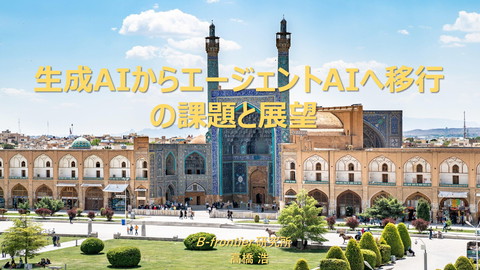Platform Adaptation and Challenges in Smart Cities
>100 Views
September 17, 19
スライド概要
スマートシティが世界的に話題になっている。普遍的定義はなさそうだが、“スマートシティ”として想像されているビジョンは世界全体で驚くほど一貫している。つまり、「情報やデータにより、都市は、公共交通機関から電力使用、廃棄物管理から給水まで、都市生活のあらゆる側面が完全に制御できる」のような。
この技術的考え方は、都市全体に設置されたセンサーやデバイスを含むデジタルインフラストラクチャの包括的システムで、人々の動きや交通移動、公共交通機関、エネルギー使用などに関する膨大なデータの蓄積によって、一見、実現の可能性が増大したとの印象を与えている。しかし、それには、エネルギー最適化やスムーズな管理など理想的で効率的なデジタルインフラストラクチャシステムの構築が前提である。そして、巨大システムの構築には苦労が絶えないものだ。そんな風な目で見ると、このような側面での苦労話はあまり語られていない気がする。
このような問題意識から、期待の高まっているスマートシティ構築の裏方としてのシステム構築の様々な検討内容を多少サーベイしてみた。
定年まで35年間あるIT企業に勤めていました。その後、大学教員を5年。定年になって、非常勤講師を少々と、ある標準化機関の顧問。そこも定年になって数年前にB-frontier研究所を立ち上げました。この名前で、IT関係の英語論文(経営学的視点のもの)をダウンロードし、その紹介と自分で考えた内容を取り交ぜて情報公開しています。幾つかの学会で学会発表なども。昔、ITバブル崩壊の直前、ダイヤモンド社からIT革命本「デジタル融合市場」を出版したこともあります。こんな経験が今に続く情報発信の原点です。
関連スライド
各ページのテキスト
Platform Adaptation and Challenges in Smart Cities B-frontier Laboratory Hiroshi Takahashi
Is there a myth in smart city? 2
Problem recognition • How will “smart city” build future cities? • Technology is starting to play a key role for cities’ sustainability plans. • This is because it is believed that new technology can provide a robust solution that are of benefit to citizens. • Cities aim to incorporate smart systems in their industrial, infrastructural, educational, and social activities. • However, achieving this goal requires advanced support for the development and operation of applications in a complex environment. • Can the platform provide an integrated infrastructure that enables solutions for smart cities? 3
Performance of existing platforms Name Sentilo Characteristics The project began in 2012 with the Barcelona City Council and was Yes used to put Barcelona at the forefront of SCs . Smart The project is not intended to be limited solely to the city of Santander Santander but is intended to extend to other cities such as Belgrade, Guildford, or Lubeck. ① Open source No IBM IOC This is a private platform, owned by the IBM company, which is No located in different cities around the world, such as Rio de Janeiro. CitySDK This aims to provide a programming structure for deploying SCs systems, which has been tested in 8 cities in Europe. No Open Cities This is a platform that allows users to use the data stored on it in order to be used by developers to offer services in cities. Yes i-SCOPE This is a platform that provides three types of services such as optimizing energy consumption, environmental control to SCs. No People This is a platform that provides services for the community to use and share those they develop, always oriented towards SCs. Yes IoT Open platform This is a platform that provides a set of libraries, technical documentation, web services, and protocols in an open way. Yes 4 Pablo Chamoso, et al., “Tendencies of Technologies and Platforms in Smart Cities: A State-of-the-Art Review ”, Wireless Communications and Mobile Computing Volume 2018.
Current situation and future activities • Smart cities are emerging as a potential solution to tackle common problems by efficiently using urban resources and providing quality services to citizens. • However, despite various advances to support future smart cities, there is still no generally accepted platform. • Most existing solutions do not provide the flexibility to share between cities. • For this reason, it is very important to search for various initiatives that challenge new needs. 5
Search for Three Aspects towards Future Improvement Application • Citizen centric services Platform for developing and sharing AP • Edge-based Platform Platform that hides the network • Platform scalability Platform for infrastructure expansion and contraction
References Citizen centric services ⑤ 2017 ⑥ 2017 Edge-based Platform ③ 2017 ④ 2018 Platform scalability 2018 ① ② 2019
Platform Scalability? • The extensive use and development of non-opensource software leads to interoperability issues and limits the collaboration. • The use of a microservices architecture to solve these issues is the practical challenges in smart city platforms. • InterSCity is a microservice-based open source smart city platform that supports collaborative, novel smart city research, development, and deployment initiatives. • The microservice approach enables a flexible, extensible, and demonstrates the scalability of this 8 platform.
• The scalability demands vary according to the characteristics of the city, as well as those of the deployed applications and services. • Despite its importance, platform scalability had not received the necessary attention in smart city research. • Platforms for smart cities usually implement complex distributed architectures, requiring considerable effort to run, configure, and test them. • Therefore, a simulator that supports comprehensive performance and scalability experiments on the InterSCity platform is required, especially when considering realistic and large-scale smart city scenarios. 9
By implementing a microservices architecture, the InterSCity platform decomposes its functionalities across a set of small, interconnected, collaborative services. ② Arthur de M. Del Esposte, et al., “Design and evaluation of a scalable smart city software platform with large-scale simulations”, Future Generation Computer Systems 93 (2019) 427–441. 10
InterSCSimulator is an open-source, scalable simulator for largescale smart city scenarios. The simulator is implemented in Erlang, a language suitable for the development of highly parallel and distributed applications. ② Arthur de M. Del Esposte, et al., “Design and evaluation of a scalable smart city software platform with large-scale simulations”, Future Generation Computer Systems 93 (2019) 427–441. 11
Brief Summary of InterSCity • A mechanism to evaluate the scalability and performance of the InterSCity platform is established by the integration of the platform and the InterSCSimulator. • To achieve a more representative workload for assessing the platform, InterSCSimulator models is extended with real data gathered from a large metropolis. 12
Edge-based Platform ? • “The edge computing paradigm” through the exploitation of the agent metaphor and a distributed network of computing nodes • A platform for Smart City has to be geographically and functionally extensible to grow up with the physical environment and meet the increasing needs and demands of city users. 13
Layers of Proposed Platform iSapiens iSapiens relies on two main abstractions: Virtual Objects (VOs) and Agents. VOs are used to abstract and manage physical objects, hiding the heterogeneity of devices and protocols. ③ Franco Cicirelli, et al., “An edge-based platform for dynamic Smart City applications ”, Systems 76 (2017) 106–118. Future Generation Computer 14
comprehensive view of the main features and benefits tied to iSapiens platform ③ Franco Cicirelli, et al., “An edge-based platform for dynamic Smart City applications ”, Systems 76 (2017) 106–118. Future Generation Computer 15
Characteristics of iSapiens • iSapiens is an agent-based platform providing features for designing and implementing distributed cyber physical systems and smart environments. • These functionalities are realized by exploiting edge computing, internet of things and out-ofthe-edge computing services. • Such systems are characterized by the combined exploitation of software components with heterogeneous physical devices and protocols. 16
FogFlow: Programming of IoT Services Over Cloud and Edges • Smart city infrastructure is forming a large scale Internet of Things (IoT) system. • As such IoT system has geo-distributed nature , fog computing has been considered. • However, it is a major challenge for developers to program their IoT services to leverage benefits of fog computing. • FogFlow is a standard-based approach to design and implement a new fog computingbased framework for IoT smart city platforms.
System architecture of FogFlow ④ Bin Cheng, et al., “FogFlow: Easy Programming of IoT Services Over Cloud and Edges for Smart Cities”, IEEE INTERNET 18 OF THINGS JOURNAL, VOL. 5, NO. 2, APRIL 2018.
Brief Summary of FogFlow • Existing programming models focused on batch and real-time data processing in a cluster or cloud environment. • FogFlow extended the traditional dataflow programming model for enabling fog computing. • New methods(NGSIs) are adding the several APIs to standard-based APIs. • The FogFlow framework enables easy programming of elastic IoT services. 19
Citizen centric services? • Smart Cities aim to improve the service they deliver to their citizens both in terms of economic and social impact. • IES Cities platform is enabling creative development and easy deployment of applications which aim to empower the citizen. • And also, its' promoting user-centric mobile services that exploit open data combined with user-supplied data. 20
IES Cities’ platform architecture ⑤ Unai Aguilera, et al., “Citizen-centric data services for smarter cities”, Future Generation Computer Systems 76 (2017) 21 234-247.
Characteristics of IES Cities platform • This platform focuses on easing to developers the creation of mobile services that leverage on open data and user contributed data. • This provides a solution that not only solves data source management but also focuses on reducing the gap between data consumer requirements. • This is an open platform for publishing data accessible at different sources. • This envisions fostering the creation of urban services. 22
SOM called SmartCityWare • SmartCityWare, the service-oriented middleware (SOM) can help resolve some of the challenges of developing and operating smart city services. • The technologies to support such efforts are the Cloud and Fog Computing. • However, proper integration and efficient utilization of Cloud and Fog Computing is not an easy task. • SmartCityWare abstracts services and components involved in smart city applications as services accessible model. 23
SmartCityWare services are distributed among multiple clouds, fogs, and IoT devices. Each service defines a few simple interfaces to other services. Using SOM concepts provides mechanisms to link available services to build new services. ⑥ Nader Mohamed, et al., “SmartCityWare: A Service-Oriented Middleware for Cloud and Fog Enabled Smart City Services”, 24 SPECIAL SECTION ON THE NEW ERA OF SMART CITIES:.IEEE ACCESS.2017.2731382.
Application Examples:Intelligent Traffic Light Control System The traffic light controls features monitoring devices at many locations(road sensors, on vehicle sensors, neighboring vehicles,etc) to accurately capture and model traffic patterns. By using this information, it adjusts traffic lights to optimize flow. ⑥ Nader Mohamed, et al., “SmartCityWare: A Service-Oriented Middleware for Cloud and Fog Enabled Smart City Services”, 25 SPECIAL SECTION ON THE NEW ERA OF SMART CITIES:.IEEE ACCESS.2017.2731382.
Characteristics of SmartCityWare • Similar examples are Civitas, SOFIA, VITAL, SmartUM, SMArc, GAMBAS, and CityHub. • Main differences between SmartCityWare and others is that SmartCityWare is a completely SOM that utilizes both Cloud and Fog Computing to provide various services for smart cities. • Also, main advantages of this approach is the flexibility of extending the middleware itself to include new and more advanced services to support smart city. 26
Brief Summary Citizen centric services IES Cities open platform reduce the gap between data consumer requirements SmartCityWare service-oriented middleware Integration of Cloud and Fog Computing Edge-based Platform iSapiens edge computing paradigm Abstractions of VOs and Agents. FogFlow new dataflow programming model easy programming of elastic IoT services Platform scalability InterSCity/ InterSCSimulator Open source software microservices architecture scalability of the platform 27
Overview of listed proposals • Various attempts have emerged from ease of programming to platform scalability. • At present, cities of all sizes are including Smart City proposals in their urban sustainability programs. • Smart city focuses on providing social benefits, economic growth, and creating new opportunities. • However, there is still a big gap between expectations and proposals. 28
Realization status of each project Architecture Design/ Development Evaluation/Vali dation/Test Deployment to actual system IES Cities Platform ++ + ++ + (Open Platform) (services that leverage on open data and user contributed data) (validate platform taking into account the different roles of stakeholders) (applied in four different European Cities) SmartCityWare Service ++ + + / (abstract services as services accessible model) (SmartCityWare prototype was implemented.) (Utilize the flexibility and extensibility based on SOM architecture) iSapiens Platform ++ ++ + + (Virtual Objects (VOs) and Agents) (guidelines for design and implementation of smart city applications ) (as a significant case study, the design of a real Smart Street in the city of Cosenza (Italy) ) (the implementation of a real Smart Street in the city of Cosenza (Italy) ) FogFlow ++ + + / (fog computing based framework) (New methods adding the several APIs to standardbased APIs) (3 case studies) ++ + ++ + (microservices architecture, open source) (real data gathered from metropolis) (experimental results to demonstrate the benefits on scalability and performance) (some case studies such as Sao Paulo) Stage Project Name InterSCity Platform/InterS CSimulator 29
Current status of proposals • Many of the proposals have been developed as prototypes, and small scale adaptations are being attempted. • Some of them contain detailed evaluation information, but each proposal has not yet been fully introduced into the actual system. • Since full-scale implementation also requires integration with other components, many proposals are expected to enter the deployment stage in the future. 30
Summary • There is no myth in system development. • The emergence of numerous proposals suggests various barriers to system development. • In addition, new challenges are anticipated in the spread of systems. • The platform is considered effective in solving or responding to these challenges. 31





